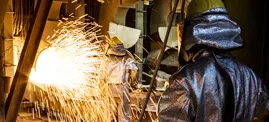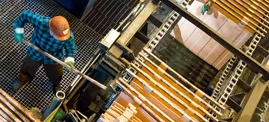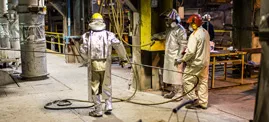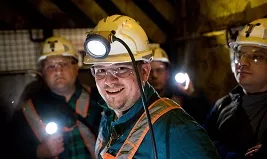The Management Board of KGHM Polska Miedź S.A., in accordance with corporate governance principle 18 of the document "Best practices in public companies 2005" hereby provides the text of the Concise evaluation of the situation in KGHM “Polska Miedź” S.A. as carried out by the Supervisory Board of the Company.
Concise evaluation of the situation in KGHM Polska Miedź S.A.
during the period from 1 January 2005 to 31 December 2005
presented to the General Shareholders Meeting
(approved by the Supervisory Board of KGHM Polska Miedź S.A. on 25 April 2006)
1. Macroeconomic conditions in 2005.
In 2005 there was a significant increase in the price of copper on the global market. The average annual electrolytic copper price on the London Metal Exchange in 2005 increased to 3 684 USD/t and was 28.5% higher than in 2004, when it amounted to 2 868 USD/t.
Silver prices on the global market in 2005 reached 235 USD/kg (7.31 USD/troz). The average annual silver price according to the London Bullion Market was higher by 9.8% than in 2004, when it amounted to 214 USD/kg (6.66 USD/troz). The average USD exchange rate in 2005 was 3.23 PLN/USD and was 11.5% lower than that of 2004 (3.65 PLN/USD).
2. Basic results and significant events.
Management Board
During the period from 1 January 2005 to 23 June 2005 the Management Board of KGHM Polska Miedź S.A. was comprised of the following persons:
- Wiktor Błądek President of the Management Board
- Jarosław Andrzej Szczepek I Vice President of the Management Board, Vice President of the Management Board for Finance-Economics
- Andrzej Krug Vice President of the Management Board for Employee Affairs
- Robert Nowak Vice President of the Management Board for Trade, Marketing and Hedging
- Marek Szczerbiak Vice President of the Management Board for Production
On 23 June 2005 the Supervisory Board of KGHM Polska Miedz S.A. recalled Wiktor Błądek as President of the Management Board and appointed him as a Vice President of the Management Board, and simultaneously appointed Marek Szczerbiak as President of the Management Board, while Sławomir Pakulski was appointed as a Vice President of the Management Board of KGHM Polska Miedź S.A. Following these changes the Management Board was comprised of the following persons:
- Marek Szczerbiak President of the Management Board
- Jarosław Andrzej Szczepek I Vice President of the Management Board, Vice President of the Management Board for Finance-Economics
- Wiktor Błądek Vice President of the Management Board for Mining
- Andrzej Krug Vice President of the Management Board for Employee Affairs
- Robert Nowak Vice President of the Management Board for Trade, Marketing and Hedging
- Sławomir Pakulski Vice President of the Management Board for Smelting
On 19 December 2005 the Supervisory Board resolved to suspend from performance of the duties of Vice President Wiktor Błądek and Andrzej Krug for a period not longer than three months.
Production:
Due to a decrease in the amount of copper contained in ore there was a decrease in the amount of copper in concentrate. The amount of mineral extracted from ore decreased from 26 418 thousand tonnes in 2004 to 25 662 thousand tonnes in 2005, alongside a simultaneous decrease in the amount of copper contained in ore from 1.97% in 2004 to 1.89% in 2005. 511 536 tonnes of Cu in concentrate were produced in relation to the decreased planned amount of 514 564 tonnes of Cu in concentrate. Meanwhile 560 255 tonnes of electrolytic Cu were produced, which is a record result for the Company. This was however achieved by utilising nearly all of the production inventory of anodes, which were in any case at a relatively low level as a result of the fire at the HM Legnica smelter in 2004 (at the end of 2003 anode inventories amounted to 19 690 tonnes of Cu, at the end of 2004 anode inventories amounted to 9 960 tonnes of Cu, and at the end of 2005 anode inventories amounted to 1 898 tonnes of Cu). As a result in 2006 and in subsequent years it will be necessary to rebuild anode inventories and to significantly increase purchases of external concentrate. The assumed increase in the volume of external copper consumption and the necessity of rebuilding production inventories which were used to achieve the record production level of 2005 led to a significant increase in the cost of production in the Company from 7 723 PLN/tonne of Cu achieved in 2005 to the approved Budget amount of 8 910 PLN/tonne of Cu in 2006.
Financial results
In 2005 552 275 t of copper and copper products were sold, i.e. 1.8% more than in 2004. Silver sales in comparison to 2004 fell to 1 250 tonnes, and were lower by 8.5% (116 t).
Thanks to the increase in copper prices revenues from its sale increased in 2005 by 32.6% (PLN 1 658 434 thousand). Revenues from the sale of silver remained at a comparable level to those in 2004 and amounted to PLN 902 361 thousand. The decrease in the volume of silver sold was compensated by the increase in its price.
Altogether revenues from sales amounted to PLN 7 924 195 thousand, i.e. 27% more than in the previous year. The value of revenues from sales in 2005 reflects the negative result from the settlement of commodity hedging instruments in the amount of PLN (425 289) thousand (in 2004 PLN (1 097 590) thousand) and profit from the realisation of currency hedging instruments of PLN 169 760 thousand (in 2004 PLN 165 272 thousand).
Profit before extraordinary items and taxation in 2005 amounted to PLN 2 634 563 thousand and was higher by 82.2% in relation to the previous year. Earnings per share amounted to PLN 11.45. Return on assets (ROA) increased from 15.6% to 20.9%, while return on equity increased from 26.2% to 36.8%.
Costs
The cost of production increased from 6 660 PLN/t of copper in 2004 to 7 723 PLN/t of copper in 2005.
The increase in the unit cost of copper production in relation to 2004 by 16%, i.e. by 1 063 PLN/t of Cu was achieved mainly due to an increase in labor costs, the amount of fuels consumed and in mining materials and milling agents. Also of significance was the decrease in the amount (by 10%) and value (by 2%) of suspended anode slimes mainly due to a change in the structure of batch materials for the production of electrolytic copper and to a decrease in silver content in internal concentrates. The higher costs were also the result of an increase in repair costs and to a significant increase in payments due to rationalisation and bonuses for implementation.
3. Selected problems requiring attention.
3.1. Since the second half of 2003 the settlement of hedging transactions has had a significant negative impact on the financial results of the Company. Respectively, in 2004 PLN (890.3) mln, in 2005 PLN (314.4) mln and as much as PLN (312.7) mln for the first quarter of 2006 alone.
In the opinion of the Supervisory Board the hedging policy – especially as respects prices – demands significant changes. This question is one of the main areas of interest of the Management Board of the Company and the Supervisory Board in 2006. Given the significant increase in copper and silver prices and the probability that such prices will continue to prevail in 2006, hedging strategies should enable the Company to take advantage of the majority of any increases in metals prices.
3.2. A significant element of the Company’s costs is payments made for inventions, rationalisation projects and the implementation of research. Total payments in the Company in this regard amounted in 2005 to PLN 41 843 563. For many of these projects there exist doubts as to whether they meet the general criteria for being defined as innovation activities. Actions are currently underway in the Company aimed at improving this situation.
3.3. The main task of the Management Board over the next several years should be to undertake actions leading to a decrease in production costs.
3.4. Decisions should also be taken as respects reviewing the investment program, so as to allow the Company to avoid incurring high costs of preparatory work without a proper analysis of the goals of a given investment project. Analysis should also be made of the possibility of carrying out the investment program as respects its usefulness for the development of the Company and the increase in its value.
The problems described above are a priority for the Management Board and the Supervisory Board in 2006.
(Translation from the original Polish version. In the event of differences resulting from the translation, reference should be made to the official Polish version.)





